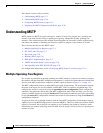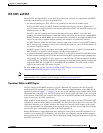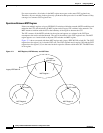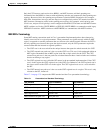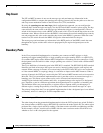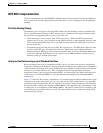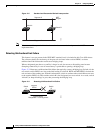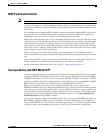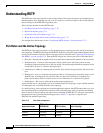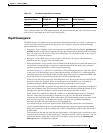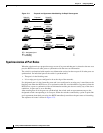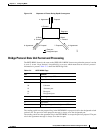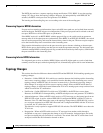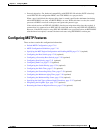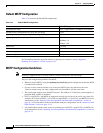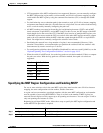
17-10
Catalyst 2960 and 2960-S Switch Software Configuration Guide
OL-8603-09
Chapter 17 Configuring MSTP
Understanding RSTP
Understanding RSTP
The RSTP takes advantage of point-to-point wiring and provides rapid convergence of the spanning tree.
Reconfiguration of the spanning tree can occur in less than 1 second (in contrast to 50 seconds with the
default settings in the IEEE 802.1D spanning tree).
These sections describe how the RSTP works:
• Port Roles and the Active Topology, page 17-10
• Rapid Convergence, page 17-11
• Synchronization of Port Roles, page 17-12
• Bridge Protocol Data Unit Format and Processing, page 17-13
For configuration information, see the “Configuring MSTP Features” section on page 17-15.
Port Roles and the Active Topology
The RSTP provides rapid convergence of the spanning tree by assigning port roles and by learning the
active topology. The RSTP builds upon the IEEE 802.1D STP to select the switch with the highest switch
priority (lowest numerical priority value) as the root switch as described in the “Spanning-Tree Topology
and BPDUs” section on page 16-3. Then the RSTP assigns one of these port roles to individual ports:
• Root port—Provides the best path (lowest cost) when the switch forwards packets to the root switch.
• Designated port—Connects to the designated switch, which incurs the lowest path cost when
forwarding packets from that LAN to the root switch. The port through which the designated switch
is attached to the LAN is called the designated port.
• Alternate port—Offers an alternate path toward the root switch to that provided by the current root
port.
• Backup port—Acts as a backup for the path provided by a designated port toward the leaves of the
spanning tree. A backup port can exist only when two ports are connected in a loopback by a
point-to-point link or when a switch has two or more connections to a shared LAN segment.
• Disabled port—Has no role within the operation of the spanning tree.
A port with the root or a designated port role is included in the active topology. A port with the alternate
or backup port role is excluded from the active topology.
In a stable topology with consistent port roles throughout the network, the RSTP ensures that every root
port and designated port immediately transition to the forwarding state while all alternate and backup
ports are always in the discarding state (equivalent to blocking in IEEE 802.1D). The port state controls
the operation of the forwarding and learning processes. Table 17-2 provides a comparison of
IEEE 802.1D and RSTP port states.
Table 17-2 Port State Comparison
Operational Status
STP Port State
(IEEE 802.1D) RSTP Port State
Is Port Included in the
Active Topology?
Enabled Blocking Discarding No
Enabled Listening Discarding No
Enabled Learning Learning Yes



